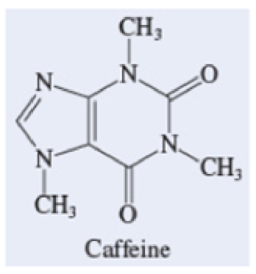
Concept explainers
Caffeine, the stimulant in coffee and tea, is a weak base that ionizes in water according to the equation

A 0.15-M solution of caffeine at 25°C has a pH of 8.45. Determine the Kb of caffeine.
Interpretation:
The
Concept Information:
Base ionization constant:
The ionization of a weak base
The equilibrium expression for the ionization of weak base
Where,
pOH definition:
The
Relationship between pH and pOH
The relationship between the hydronium ion concentration and the hydroxide ion concentration is given by the equation,
As
To Calculate: The
Answer to Problem 16.15WE
Answer
The
Explanation of Solution
Given data:
Caffeine is the stimulant in tea and coffee.
Caffeine is a weak base which ionizes in water as follows,
The pH of the given 0.15 M solution of caffeine is 8.45
Calculation strategy:
Using the given pH, the pOH can be found, then from pOH obtained, the hydroxide ion concentration is calculated.
From the obtained hydroxide ion concentration, use reaction stoichiometry to determine the other equilibrium concentrations, then evaluate
Calculation of pOH:
The pOH can be calculated using the following formula as follows,
Therefore, the pOH of the given caffeine solution is 5.55
Calculation of hydroxide ion:
The hydroxide ion can be calculated as follows,
Therefore, the concentration of
Calculation of
The concentration of hydroxide ion for the given weak base can be found out from its equilibrium reaction with water.
Based on the stoichiometry,
If the concentration of
We summarize the changes as follows,
|
| |||
|
Initial
|
0.15
|
|
|
|
Change
|
|
| |
|
Equilibrium
|
|
| |
Therefore, the base ionization constant
The
Want to see more full solutions like this?
Chapter 16 Solutions
CHEMISTRY: ATOMS FIRST VOL 1 W/CONNECT
- A solution of baking soda, NaHCO3, has a pH of 10.08. What is the percent (by mass) of NaHCO3 in a 235-mL solution? (Assume a density of 1.00 g/mL.)arrow_forwardPapaverine hydrochloride (abbreviated papH+Cl; molar mass = 378.85 g/mol) is a drug that belongs to a group of medicines called vasodilators, which cause blood vessels to expand, thereby increasing blood flow. This drug is the conjugate acid of the weak base papaverine (abbreviated pap; Kb = 8.33 109 at 35.0C). Calculate the pH of a 30.0-mg/mL aqueous dose of papH+Cl prepared at 35.0C. Kw at 35.0C is 2.1 1014.arrow_forwardNicotinic acid, C6H5NO2, is found in minute amounts in all living cells, hut appreciable amounts occur in liver, yeast, milk, adrenal glands, white meat, and corn. Whole wheat (lour contains about 60. 0g per gram of flour. One gram (1.00 g) of the acid dissolves in water to give 60. mL of solution having a pH of 2.70. What is the approximate value of Ka for the acid? Nicotinic acidarrow_forward
 Chemistry: An Atoms First ApproachChemistryISBN:9781305079243Author:Steven S. Zumdahl, Susan A. ZumdahlPublisher:Cengage Learning
Chemistry: An Atoms First ApproachChemistryISBN:9781305079243Author:Steven S. Zumdahl, Susan A. ZumdahlPublisher:Cengage Learning
 ChemistryChemistryISBN:9781305957404Author:Steven S. Zumdahl, Susan A. Zumdahl, Donald J. DeCostePublisher:Cengage Learning
ChemistryChemistryISBN:9781305957404Author:Steven S. Zumdahl, Susan A. Zumdahl, Donald J. DeCostePublisher:Cengage Learning Chemistry: Principles and PracticeChemistryISBN:9780534420123Author:Daniel L. Reger, Scott R. Goode, David W. Ball, Edward MercerPublisher:Cengage Learning
Chemistry: Principles and PracticeChemistryISBN:9780534420123Author:Daniel L. Reger, Scott R. Goode, David W. Ball, Edward MercerPublisher:Cengage Learning General, Organic, and Biological ChemistryChemistryISBN:9781285853918Author:H. Stephen StokerPublisher:Cengage Learning
General, Organic, and Biological ChemistryChemistryISBN:9781285853918Author:H. Stephen StokerPublisher:Cengage Learning Chemistry: Principles and ReactionsChemistryISBN:9781305079373Author:William L. Masterton, Cecile N. HurleyPublisher:Cengage Learning
Chemistry: Principles and ReactionsChemistryISBN:9781305079373Author:William L. Masterton, Cecile N. HurleyPublisher:Cengage Learning





